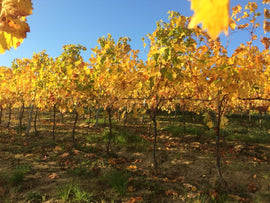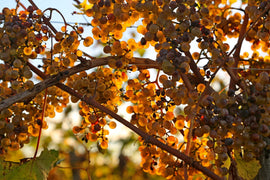TOSCANA
Of all the convoluted, impenetrable, byzantine, clarity-hostile, sense-taunting barriers to understanding that the wine world tends to construct, the whole ‘Montepulciano’ pre-fab may be the most gratuitously unhelpful. Years ago, it even almost derailed yours truly’s nascent career. Having gotten a job in a wine shop despite knowing virtually* nothing about the subject, I checked out The Idiots Guide to Wine from the library, got to the part about Montepulciano and, in frustration, nearly threw the book across the room and gave up on the whole thing. But ruining a library book is kind of a karmic catastrophe and besides, I needed the job. So I took a deep breath, kept on reading, and here we are.
I think it’s possible that I’ve been carrying a latent bias against Vino Nobile de Montepulciano ever since though, since this is the first time I’ve ever used one in the Italian Wine Club. In my defense, here’s why: Montepulciano is both the name of an ancient hilltop town in Tuscany, and a grape grown all over central Italy, but primarily associated with the Abruzzo region (it is in fact, the 2nd most planted red varietal in Italy full-stop, after Sangiovese.) They DO NOT grow the grape Montepulciano in the town of Montepulciano however; there, the Vino Nobile di Montepulciano DOC (est. 1966) and DOCG (1980) designations require at least 70% of each bottling consist of Prugnolo Gentile, which is the local name for the same Sangiovese clone used in Brunello di Montalcino DOCG wines - where it is called Sangiovese Grosso. The remainder can be made up of the Caniolo Nero grape, other local varietals like Mammolo (even trace amounts of white ones), and the resultant blend must be aged at least two years before release, of which one must be in wooden casks.
Got all that? No? I know just how you feel. (I mean how does that make any sense? Given that only 2.5% of the population spoke the standardized Italian language upon unification in 1861, it stands to reason there are different words for the same thing; I just didn’t think I’d have to deal with the same word for different things as well.)
Anyway, very generally the most important thing to remember is that on the Sangiovese spectrum, Vino Nobile di Montepulciano tends to fall somewhere between Chianti and Brunello. It can be fuller and more elegant than Chianti, with riper tannins and darker fruit (‘Prunello gentile’ means “gentle plum”), but not quite as opulent or ostentatious as Brunello. And after spending a couple of decades in Brunello’s shadow, Vino Nobile di Montapulciano is having a moment in the sun of late. Local producers are done trying to match their neighbor’s famous boldness, and are instead highlighting the unique qualities of their hometown terroir. While there are a lot of great new labels right now, this month, we are featuring one of the oldest and most consistent: Le Berne, which has been around since the 1960s.
The white selection, like many of the most interesting lighter hued wines coming out of Tuscany these days is, in fact, orange, since the grapes see some skin contact. In this case old vine Trebbiano from about 20km outside of Florence spends three months on its skins, and then a further 6 months in local clay amphoras. Prismatic and remarkably textured - salty, savory, aromatic and fruity - its protean streak is nicely structured by a balanced acidity.
Salut,
Alan Hicks - Wine Buyer, Noe Valley
(*I was aware wine came in different colors.)
|
Sammontana Primo Fuoco Bianco Toscana IGT 2021 |
|
|
Region: Tuscany |
About the Winery: Sammontana dates back to the 12th century and was once property of the acclaimed Medici family. Historically, the hamlet thrived from the production of grains, olive oil, wine and terracotta. Purchased in the 1860s by a Polish family, the winery is still today in their care after 4 generations. Wine has become the predominant business, thanks to 13 hectares of vineyards planted and maintained according to biodynamic farming. Throughout the winemaking process, experimentation is prevalent and while the approach rests largely on the laurels of the land, the current generation is inspired to create clean wines that avoid manipulation, chemicals, filtration, or clarification with a healthy dose of personality. Gently sloping hillsides bordering the east side of the Arno river valley just 20km from Florence in Montelupo Fiorentino are host to Sammontana’s vineyards, planted between 70 and 150 meters above sea level. The soils here are alluvial, full of stones, gravel and pebbles which have historically posed as a nuisance to farmers but Sammontana feels they give character and personality to the wines. About the Winemaking: In the language of local pottery making, “Primo Fuoco” is the initial clay firing that leads to the creation of terracotta, an art that once defined the village of Montelupo near Sammontana. Primo Fuoco Bianco is an acute selection of the estate’s best Trebbiano grapes, fermented naturally and macerated on the skins for about 3 months before being matured for 6 months in a 500-liter terracotta amphora made from local red clay. Only 1,200 bottles are produced. Tasting Notes: Nice burnt amber color in the glass. Nose carries aromas of golden apples and peaches, herbs and honeysuckle. Palate adds orange peel, earl gray tea, saline minerality and creme brulee crust. |
|
Winemaker: Daniele & Dario Dzieduszycki |
|
|
Price per bottle / per case $36.99/$399.50 |
|
|
Suggested Food Pairing: Cured meats Halibut or other white fish Lentil Stew Green Curry Mapo Tofu Szechuan Garlic Chicken Stir Fry |
|
|
Le Bèrne Vino Nobile de Montepulciano 2021 |
|
|
Region: Nobile di Montepulciano DOCG |
About the Winery: The name “Le Bèrne,” derived from the Etruscan word for “The Hill,” reflects its timeless connection to the landscape. In 1967, Giuliano Natalini and his father, Egisto Natalini, acquired the sharecropping farm where their family had once lived and worked the land. Setting aside mixed cultivation, they planted their first vineyard, laying the foundation for Le Bèrne’s wine production. Over the decades that followed, Giuliano and his wife, Ada, poured their devotion into the vineyards and refined their winemaking practices, ever focused on elevating the quality of their grapes. This blend of thoughtful viticulture and meticulous craftsmanship lies at the heart of Le Bèrne’s philosophy, affirming their enduring commitment to excellence and the land they cherish. About the Winemaking: 100% Sangiovese from avg. 30 year old vines. White calcareous clay to marine red sand rich in iron. Natural fermentation without added yeasts, daily pumping overs with about 25 days of skin contact Aging in big 25 HL Slavonian oak barrels and partially in French barriques for 24 months. Tasting Notes: Violets, dried cherry & earth. Silky tannins, bright acidity. Persistent, with well integrated oak. Full and round on the palate, with firm tannic finish. |
|
Winemaker: Andrea and Laura Natalini |
|
|
Price per bottle / per case $28.99/$313.10 |
|
|
Suggested Food Pairing: Tortelli di patate alla toscana (see recipe) Ragù of wild boar, Pork sausages, salumi, and grilled or roasted lamb roasted wild mushrooms over polenta Tagliatelle with black truffles and olive oil. |
|
Tortelli di Patate alla Toscana
This traditional Tuscan recipe is typical of the provinces of Firenze and Prato. The tortello is a big
ravioli stuffed only with a potato mix without any meat. It is served either with meat sauce (duck ragu is recommended), or with butter, sage and Parmigiano cheese.
Ingredients:
(serves 6)
• 400gr flour 00 (double zero)
• 50gr semolina flour
• 6 eggs
• 1kg potatoes (Russets or Yukon Gold)
• 1⁄2 tbsp. butter
• 3 tbsp. Parmigiano cheese
• 1 tsp. freshly grated nutmeg
• Salt & pepper
Instructions:
-
On a clean surface make a mound with the semolina flour
-
Create a hollow space in the middle of the flour and crack inside 4 eggs
-
Mix the compound until the dough doesn’t get smooth and elastic
-
Let rest for half hour covered by a humid dish towel
-
In a pot filled with cold water add the potatoes and bring to boil until cooked
-
Peel the potatoes and press them through a ricer
-
Add 2 eggs, butter, parmigiano, nutmeg, salt & pepper to the potatoes and mix together
-
Set the filling aside
-
Get the pasta dough and cut it in two pieces
-
Using a rolling pin roll the dough until you get a smooth sheet, thin but strong enough to stretch
-
Roll the other sheet of pasta dough in the same way and set aside being careful that it doesn’t stick together
-
Make small balls, about 1⁄2 inch big, with the potatoes stuffing and set on the pasta sheet on the table at 2 inch distance from each other filling all the sheet
-
Delicately set the other pasta sheet on top of the other one
-
With your fingers press gently around each filling to get rid of any air
-
When all the stuffings are properly pressed and using a ravioli cutting wheel cut a square of dough with the filling in the center separating each tortello
-
Bring a pot of water to boil and cook the tortelli
-
It will not be a long time, as soon they start to float you should drain them and dress with your favorite sauce





